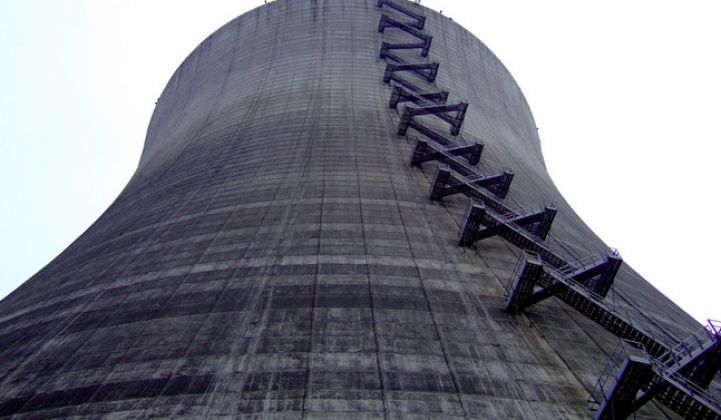It's been a good year so far for advanced nuclear reactors.
Last week, small modular reactor startup Terrestrial Energy closed $8 million in funding for its proprietary Integral Molten Salt Reactor design. These advanced small nuclear reactors are intended for industrial process heat applications, with market deployment targeted "in the 2020s." The molten salt reactor is an advanced design in which the nuclear fuel is dissolved in the coolant itself, typically a molten fluoride salt mixture. MSRs can run at higher temperatures and higher efficiencies than water-cooled reactors.
Earlier this week, a bipartisan bill won approval by the U.S. House of Representative's Committee on Science, Space and Technology to drive R&D funding for nuclear power in the U.S. According to The Hill, "The bill directs the Department of Energy to prioritize nuclear energy research that utilizes private sector funding." The legislation encourages private firms to partner with the national labs to study nuclear reactor technology, and calls for the DOE to "complete a research reactor within the next 10 years."
And this morning, the DOE announced the selection of two companies, X-energy and Southern Company, "to further develop advanced nuclear reactor designs." These awards originate from the Gateway for Accelerated Innovation in Nuclear (GAIN) program.
DOE’s initial funding will be $6 million for each project, with both firms providing cost-share. The potential "multi-year cost-share value for this research is up to $80 million," and it is aiming for a demonstration project in about 20 years, according to the DOE.
The advanced nuclear power projects receiving awards are:
- X-energy in partnership with BWX Technology, Oregon State University, Teledyne-Brown Engineering, SGL Group, Idaho National Laboratory, and Oak Ridge National Laboratory (ORNL) to further develop its advanced pebble-bed reactor, a high-temperature gas-cooled reactor fueled by "tennis-ball-sized graphite spheres." China is constructing approximately 250 MWe of pebble-bed reactor capacity with plans for more, according to X-energy.
- Southern Company Services is partnering with TerraPower, EPRI, Vanderbilt University, and ORNL to perform tests and materials suitability studies to support development of a Molten Chloride Fast Reactor. GTM reported on the Khosla- and Bill Gates-funded TerraPower's unorthodox approach to reactor design with its Traveling Wave Reactor, but in this instance, the company is exploring a less radical molten salt design.
As we've suggested, the regulatory challenge of advanced reactors could be more of an obstacle than the physics or finance. The Nuclear Regulatory Commission has regulated more than 100 reactors in the U.S., all based on the light water reactor design. It will require an enormous institutional adaptation to get this technology commercialized -- and an enormous amount of funding.
Rod Adams at the website Atomic Insights points out, "The NRC’s financing model, established in the Omnibus Budget Reconciliation Act of 1990, is the root cause preventing many [regulatory actions]. That model requires that the agency bill users of its services for 90 percent of its operating budget. When there is work needed on a generic issue that applies to numerous parties, the cost is spread among the existing base of operating licensees. The 'user fee' model sets up an inevitable tension. For good reasons, many current licensees have no interest in funding generic work to design a more efficient process for licensing advanced reactors. Not only do they want to minimize their fees, but they have a number of active issues they consider to be more pressing."
Bill co-sponsor and Committee Chairman Lamar Smith (R-Texas) noted at the hearing, “Our ability to move from R&D to market deployment has been hampered by government red tape. The U.S. has not lived up to its potential when it comes to nuclear energy."
The DOE has attempted to confront this red tape by investing up to $452 million dollars starting in 2012 "to support first-of-a-kind engineering costs associated with certification and licensing activities for SMRs through the NRC."
In a recent article for Huffington Post, Gregory Jaczko, former U.S. Nuclear Regulatory Commission chairman and commissioner, wrote, "The latest poster child for nuclear climate change salvation is a fleet of advanced reactors, which -- on paper -- do provide enticing improvements to the current generation of reactors. At best, however, this technology is several decades from becoming commercially viable, too far into the future to be relevant. The reality with nuclear power is that it has proven time and again to take longer and cost more to develop than predicted. There is nothing in the new designs nor the performance of the industry today that suggests this trend will end."
President Obama’s 2016 budget includes more than $900 million for the DOE to support U.S. civilian nuclear energy. The DOE also has $12.5 billion in remaining loan guarantee authority for advanced nuclear projects through Title 17.



